

Will's Visit for the 2017 Syrup Campaign
******************* |
|
This page will describe family time and will focus on our syrupmaking. The intended audience is myself; I use these notes to augment my memory. Notwithstanding, I hope that some parts will be interesting to others, if not today, sometime. Our syrupmaking activities have been described for 2007 and other years (2004, 2009, 2011, 2013a, 2013b). Our first cane (2002) was processed by the Griffin Mill, and the Brinsons processed our first juice the following year. Although there have been minor year-to-year variations, the processes are essentially the same and I will generally not repeat them. Over time, I have mechanized growing the cane, and our son, Will, is committed to help every year now. The most significant change is that we have moved our cane growing to the W.H. Outlaw Farm in Berrien County, Georgia. This farm was not new to sugar cane, and my mother's notes indicate that she and Daddy--along with help from tenants and her parents (the latter who owned and lived on the adjoining farm)--made 1000 gallons of syrup one year. Think about that: wood-fired kettle and animal-powered mill. I suspect, but do not know, that the juice was processed on my grandfather's farm, where my greatgrandfather had set up a little syrup "factory" soon after he bought the farm in 1905 from Uncle Steve and Aunt Polly (née Sutton) Lewis. (That deed, incidentally, was in error, as it failed to exclude a cemetery established sometime between 1859 and 1866, and which was used as late as the early 20th century, and which I now refer to as Lost Cemetery 223/10. In all likelihood, my 3d greatgrandmother Nancy née Marsh Connell, 1823-1869, was among the first buried there, as her husband and my 3d greatgrandfather John E. Connell owned this landlot at her death. Much more but not here.) It is my best guess that the mill that "went with" Daddy's farm had been removed by his grandfather Jerry S. "Buck" Sutton (Polly Lewis's brother), ca. 1912, and taken to his new farm in the 5th land district, and further, that that mill--a QFM #14 (Slide No. 10)--is now owned by Tommy and Carolyn Fletcher (the latter, my 2d cousin). I digress, but argue that context is important. . . . and, yes, I am using this page to raise awareness of the lost cemetery and to record conjectures not elsewhere. |
|
I will start off on the wrong foot and mentioned that 2017 is one year to be forgotten. There were no serious crises, but just a constant dribble of aggravations. This trend continued in the run-up to making syrup: the day before I ground, the (very good) HVAC tech spent the most of the day working on the HVAC condenser that had been installed a week earlier to replace the replacement unit (!!!); on the day of grinding, the transformer for our underground service went bad and had to be replaced, and later that day, the two-month-old freezer went out. I hope I've used up my bad luck. There was an interesting piece of mildly bad luck relating to syrupmaking. About three days before I ground, I noticed that a patch on my left forearm was moist and sticky. Who knows, so I washed it and went about my affairs. During the night, I had the same experience and concluded that my earlier clean-up was unsatisfactory, so I got up and doubled-down with my cleaning. When I awoke, my arm was wet and sticky, my shirt was wet as was the pillow, and my arm was warm. Yikes, my skin was leaking! Without belaboring the issue, I found a plethora, pun intended, of small dead spiders or mites (example image, right) in the left arm of my all-weather suit; I had left the suit in an outbuilding and it had been appropriated as a home. When I donned the suit to pressure-wash and bleach around our mill, I paid no attention to what was in the sleeves. My dermatologist, with whom I seem connected at the hip, was not surprised to hear this account and see the critters, but it was a revelation to me. I am allergic to various substances, e.g. cat dander, but did not expect to be so sensitive to such tiny little critters. Live and learn.
|
_red.jpg) |
An unusual set of circumstances led to an invitation to visit our proximate neighbors, Francine and Galt Allee, just before we started grinding cane. They own 120 acres of the original Bannerman Plantation and have restored the home (older image, 1976 image); although this map is not entirely accurate, it suffices to show the "upper pond," which is the long narrow one near the center. (We are located on the parcels to the south.) The home was constructed in 1847, 24 years after the first white, my 5th greatgrandfather Henry C. Tucker, moved to Tallahassee. This was a special day, as the Allees were taking delivery of rainbow trout for stocking in the upper pond, as they do three times each winter. We were all eager to see this operation! The image below left shows Harrison and Christine by the delivery truck (other images of them there: 1 2 ). The image below right shows the fish being installed. (Please note from the background in these images that our land is rolling (part of the Red Hills Bioregion) and is unlike the flatland of peninsular Flordia, which begins with the Cody Scarp about 18 miles south where the old B&W Fruit Stand was once located.)
|
|
_red.jpg) |
_red.jpg) |
As mentioned, we now grow our cane at the farm, but did not take "seed" cane from our homestead because of red rot and the off chance that mycelia of Armillaria might hitch a ride to the farm. We grow two varieties now: POJ (sourced from Burt McKellar) and CP 52-48 (sourced from Marge & Hansel Morris). We follow fertilization recommendations based on soil tests, and usually split the fertilizer into a mid-March and an early-June applications. (But, that doesn't count the fertilizer put to the potatoes and greens between rows. ;) ) In the past, I had been careful about not fertilizing later than early June because it is widely believed that excess or late fertilization will give the syrup a salty taste. This year, I did delay until mid-late July and applied fertilizer based on leaf appearance. Not a hint of a salty taste. That was this year, on my soil, with POJ. POJ (=Proefstation Oest Java, probably cultivar No. 213) is an heirloom cane, and probably my favorite of the nominal 20 that I have grown. It was the favorite of the late Don H. Dean (1936-2008), author of the The American Cane Mill, available on Amazon. "Brother Don" was a marvelous man. He knew that there was a strong possibility that his surgery would not be successful, and that his brain might be damaged. Unfortunately, the worst did happen. The night before his surgery, he wrote me a very long letter to express the value he placed on our friendship. Let me say that again: even as he knew he might die and might never be comforted by his beloved wife, Carol, or be in the company of this devoted children, John and Charlotte, he was thinking of others. What a selfless man whose passing is a loss to all. (Image of Don & Carrol on their farm.) POJ is described in detailed by Brandes et al. Note that it produces a "fancy quality of syrup" and that it is relative soft (and thus easier on smaller mills). It does have drawbacks (higher percentage of sucrose--which leads to cystallization--and more difficult to cultivate). CP 52-48 (Canal Point (Florida) Trial beginning in 1952, selection No. 48) is one of the three syrup varieties recommended in the last USDA bulletion on syrupmaking, which describes this cultivar in detail. In brief, it is stiff, erect, has a good root system, and produces a saccharine juice of nominally 19°. It is an excellent cane, almost fool-proof to grow, and produces a syrup equal to Yellow Gal (CP 29-116) according to Broadhead and Zummo. Some, e.g. Charles Deese, prefer it. Personally, I prefer CP 67-500 over CP 52-48, primarily because the latter is darker. However, our site is essentially disease free, so I will not take a chance and bring in another cane. I am happy. Overall, my plan is to grow POJ and if some goes wrong, CP 52-48 is my backup. But, there are many good plans. In the images below, Nedra stands in a vacant row middle between POJ on Jul 14th, 2017, (top left) and on Oct 29th, 2017 (top right). Then, Oct 29th, she moved over and I took her photograph with CP 52-48 (bottom, left). Finally, the day before I cut the cane, I took a closer image of POJ (bottom, right). I cut POJ on Nov 5th and 6th; for the first time, I mechanized the cutting by using my Stihl FS250 (40 cc) string trimmer fit with a brush blade (following the lead of Charles Deese). What an improvement! After, I discarded the tops (about a third of which stalks I cut back to fit my 6.5-ft truck bed), small cane, and some I didn't feel like I could develop a relationship with, the yield was 8.3 lbs ft-1, which extrapolates to 80 000 lbs acre-1. This is a high yield (almost double our 2016 POJ plant cane), but by no means in record territory; in a three-variety trial in Meridian MS, each of the tested varieties averaged more than 100 000 lbs acre-1 over a three-year period; Table 1. The chairman of my Reading Committee, the late Dr. C.C. Black, a Research Professor at the University of Georgia, often remarked about the high productivity of sugarcane. He was a leading authority on what was first known as the Hatch-Slack pathway, but later as C4 photosynthesis. These plants compartmentalize photosynthesis into two kinds of cells and have auxillary steps (in addition to the Calvin-Benson-Bassham cyle); this adaptation is common among tropical grasses (e.g. sugarcane, Bermuda, Bahia, crabgrass) and present in other plants (e.g. pigweed) enabling them to carry out rapid photosynthesis and attain high growth rates in high-light environments.
|
|
_N_sugarcane)_red.jpg) |
_red.jpg) |
_red.jpg) |
_red.jpg) |
I have many reasons to get up in the mornings. Among the most important are my family members. In the image (below left) stand one of our granddaughters Christine (named after my mother), our grandson Harrison (named after me), our son Will (named after me), and my spouse of forty-six years, Nedra. Sadly, our daughter Elizabeth and our too-spunky-for-prime-time granddaughter Kate were not with us for syrupmaking but we had just visited with them, and they will be back soon. In the foreground is the POJ that was ground later in the day, Nov 10th; it started out at the farm as 1100 lbs. At the homestead, on Nov 9th, mostly, I trimmed back both ends and blasted off the sugary solution at the cuts with a water hose; also, removed any fodder, and cleaned frass and whatnot from the stalks. As mentioned, the interval between harvesting the cane and grinding it was merely 4-5 days. As last year, I let my schedule drive the syrupmaking protocol when it should be and will be the other way around. It is preferable to store cane 2-4 weeks before grinding, in part because sucrose is hydrolyzed during storage. Extension scientists have put 50% as the ideal percentage of sugar that is sucrose for syrup production; I'd opt for 70% for improved thickness and decreased darkening via the Maillard Reaction. In other words, the reducing sugars formed from sucrose hydrolysis react with amines in the syrup, and darkens it. More, another time. I'm trying to make a point to Nedra that I really need a spectrophotometer so I can make rational plans for syrupmaking. We began grinding about 1630, right after returning from the Allee trout installation. By turns, Christine and Harrison were stalk handlers (this was not their first gig: 2016); Will was the mill feeder, and I was assigned to be pomace and juice handler. As juice handler, I kept the stainless screens cleaned, and then filtered again through diaper into a 60-gallon stainless barrel that contained 6 1-gallon jugs of ice, which were changed out before we went to bed. Presently, I am assembling supplies to add an additional filtration step between the barrel and the kettle. I don't know whether this is a feasible idea as Junior Cashwell tried this idea with a pool filter and it clogged too frequently. Possibly, with cleaner juice going in, we might be able to make it work. Often a colloidal sediment forms in pure cane syrup. A number of explanations have been put forth (incomplete skimming, e.g.).
|
|
_red.jpg) |
|
Alligators are always abundant at Wakulla. The image, below left, shows the first alligator we sighted this day. A little blue heron, below right, seems to pose for us. |
|
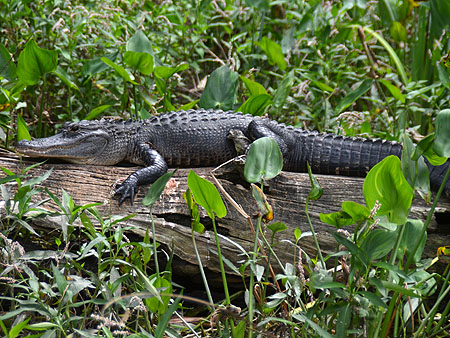 |
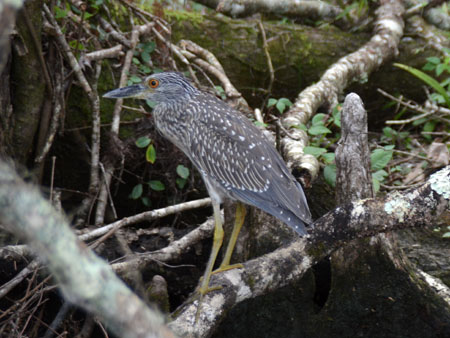 |
A moorhen and her chicks swim among the reeds (below left) and a picturesque great white egret standing alert (below right). |
|
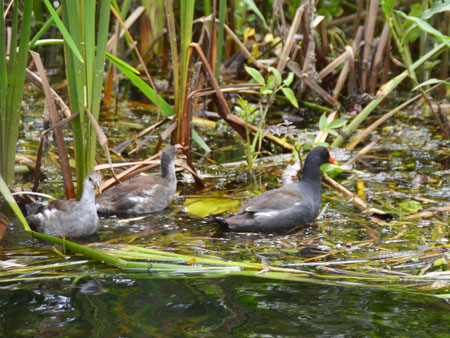 |
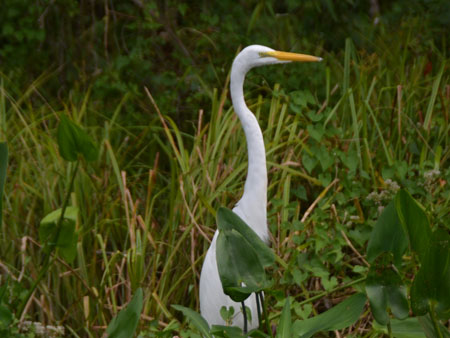 |
| Crowded turtles (below left) are a common sight, and the cardinal flower stands out in September (below right). | |
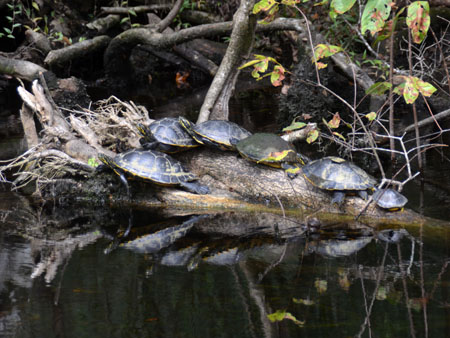 |
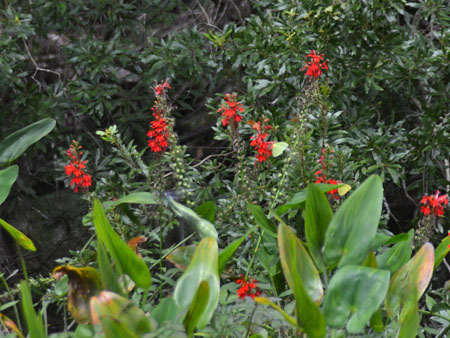 |
Regrettably, the Tarzan Tree of movie fame no longer stands, but it is memorialized by a prominent painting in the lodge (below left). We among many, many others enjoyed photographing it back in the day. The diving platform (below right) is a tamer version of its former self (courtesy of the Wakulla Historical Society), including when it was used to train soldiers for jungle warfare in World War II. A historical silent clip of some training exercises can be seen here should one have an interest. |
|
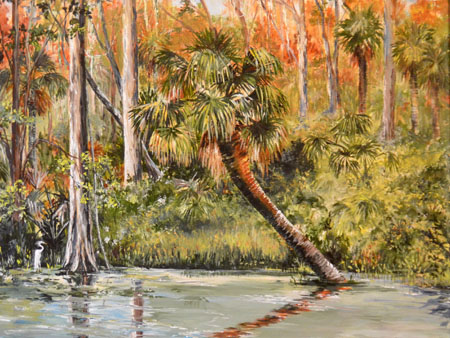 |
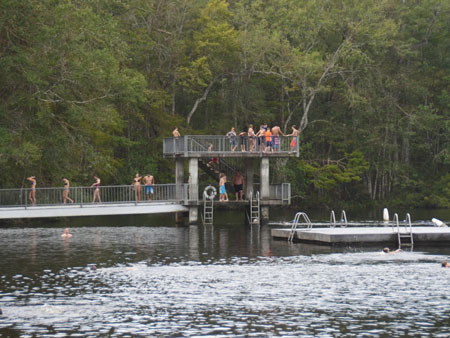 |
On our way to the lodge for lunch after the boat tour, Kate runs and runs. Such carefree fun and happiness. (Bill and I are in the background on the right image.) The lodge-dining-room chef had just changed the menu following the power outage from Hurricane Hermine, which made landfall in Wakulla County early morning, September 1, 2016. Some vegetarian and vegan choices were added, much to our delight. |
|
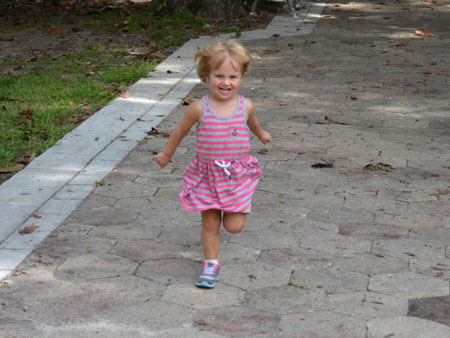 |
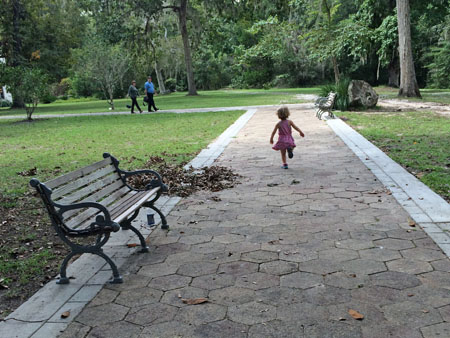 |
Relaxing around the homestead, Kate enjoyed touring our yard full of trees and other items of interest. She liked the old chicken house and nearby Chinese chestnut trees. (I had warned her of the prickly chestnuts so she kept a respectful distance.) She also enjoyed kumquats and found the nearby tractor fascinating—when she gets older, Granddaddy Bill will take her for a ride on it! Before leaving for the airport, Elizabeth made a photo of Kate with her grandparents, and we looked forward to our next visit. |
|
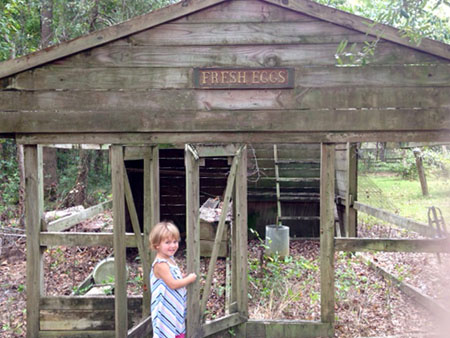 |
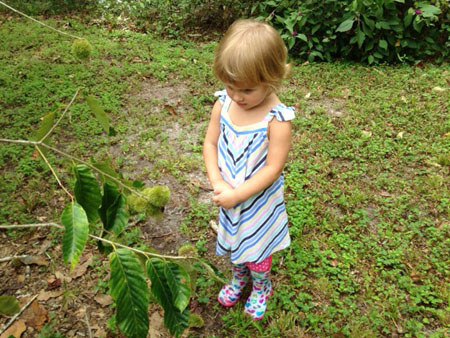 |
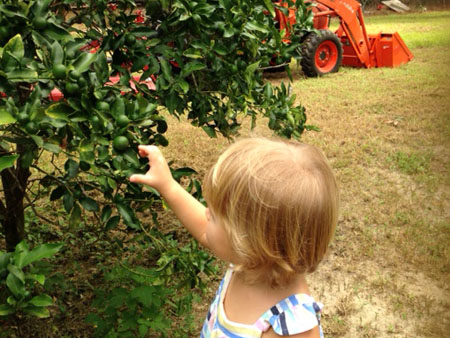 |
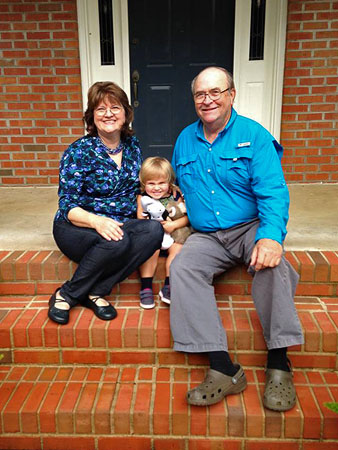 |
Return to Documentation for this page. |
|